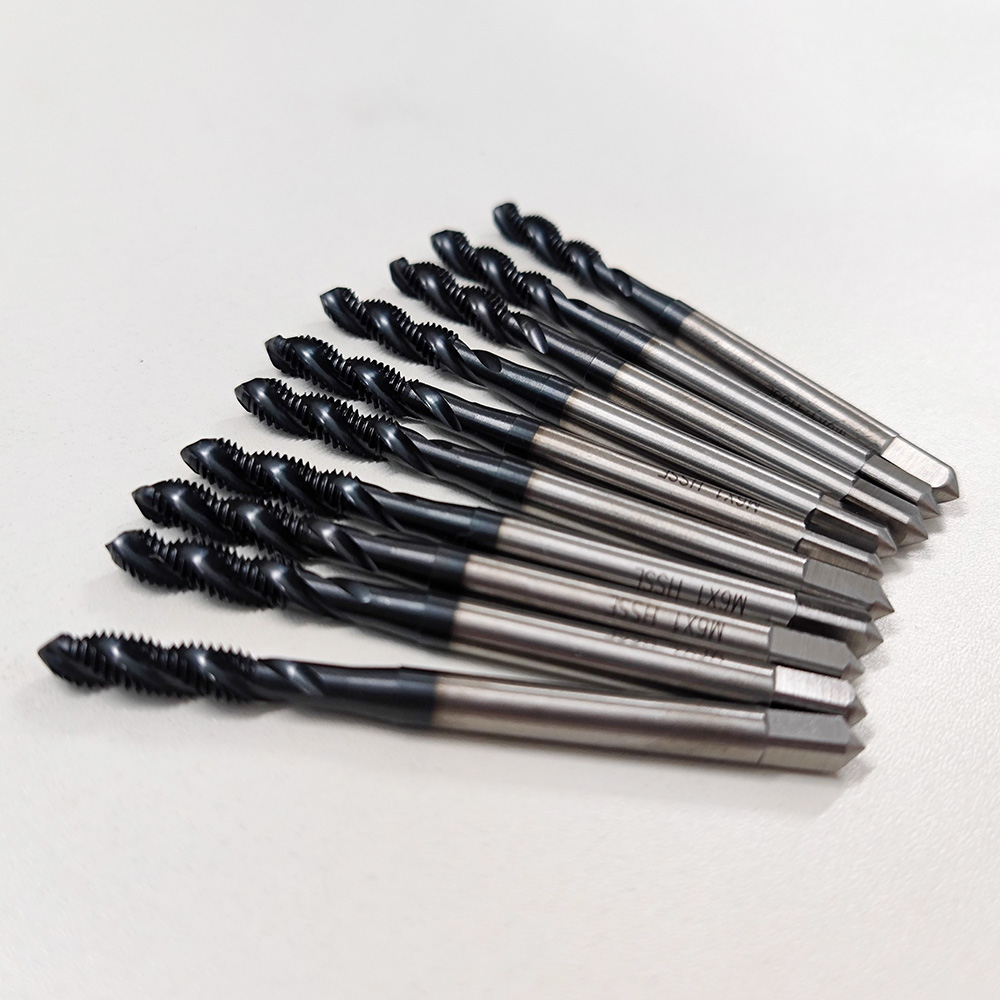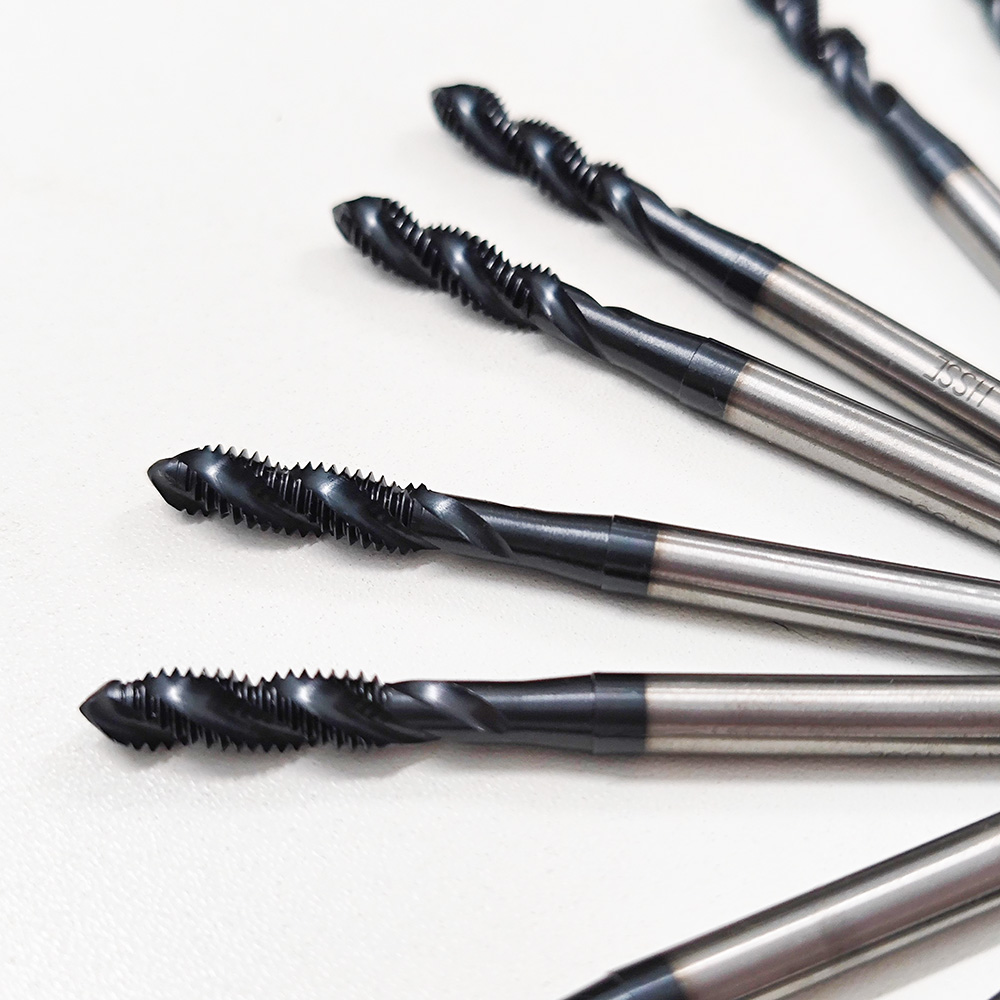1. Cutting tap
1) Straight flute taps: used for processing through holes and blind holes. Iron chips exist in the tap grooves, and the quality of the processed threads is not high. They are more commonly used for processing short-chip materials, such as gray cast iron;
2) Spiral groove tap: used for blind hole processing with hole depth less than or equal to 3D. Iron chips are discharged along the spiral groove, and the thread surface quality is high;
10~20° helix angle tap can process thread depth less than or equal to 2D;
28~40° helix angle tap can process thread depth less than or equal to 3D;
50° helix angle tap can process thread depth less than or equal to 3.5D (special working condition 4D);
In some cases (hard materials, large pitch, etc.), in order to obtain better tooth tip strength, spiral flute taps will be used to process through holes;
3) Spiral point taps: usually only used for through holes, the length-to-diameter ratio can reach 3D~3.5D, iron chips are discharged downward, the cutting torque is small, and the surface quality of the processed threads is high. It is also called an edge angle tap. or tip tap;
2. Extrusion tap
It can be used for processing through holes and blind holes. The tooth shape is formed through plastic deformation of the material. It can only be used to process plastic materials;
Its main features:
1), utilize the plastic deformation of the workpiece to process threads;
2), the tap has a large cross-sectional area, high strength, and is not easy to break;
3), the cutting speed can be higher than that of cutting taps, and the productivity is correspondingly improved;
4), due to cold extrusion processing, the mechanical properties of the thread surface after processing are improved, the surface roughness is high, and the thread strength, wear resistance, and corrosion resistance are improved;
5), chipless processing
Its shortcomings are:
1), can only be used to process plastic materials;
2), high manufacturing cost;
There are two structural forms:
1), Oil grooveless tap extrusion - only used for blind hole vertical machining conditions;
2) Extrusion taps with oil grooves - suitable for all working conditions, but usually small diameter taps are not designed with oil grooves due to difficulty in manufacturing;
1. Dimensions
1). Total length: Please pay attention to certain working conditions that require special lengthening.
2). Groove length: all the way up
3) Shank square: Common shank square standards currently include DIN (371/374/376), ANSI, JIS, ISO, etc. When selecting, attention should be paid to the matching relationship with the tapping tool holder;
2.Threaded part
1) Accuracy: Selected by specific thread standards. Metric thread ISO1/2/3 level is equivalent to national standard H1/2/3 level, but attention should be paid to the manufacturer’s internal control standards;
2) Cutting cone: The cutting part of the tap has formed a partially fixed pattern. Usually, the longer the cutting cone, the better the life of the tap;
3) Correction teeth: play the role of assistance and correction, especially when the tapping system is unstable, the more correction teeth, the greater the tapping resistance;
3. Chip flute
1), Groove shape: affects the forming and discharge of iron chips, and is usually an internal secret of each manufacturer;
2) Rake angle and relief angle: When the tap angle increases, the tap becomes sharper, which can significantly reduce the cutting resistance, but the strength and stability of the tooth tip decrease, and the relief angle is the relief angle;
3) Number of flutes: increasing the number of flutes increases the number of cutting edges, which can effectively increase the life of the tap; however, it will compress the chip removal space, which is detrimental to chip removal;
Tap material
1. Tool steel: mostly used for hand incisor taps, which is no longer common;
2. Cobalt-free high-speed steel: currently widely used as tap material, such as M2 (W6Mo5Cr4V2, 6542), M3, etc., marked with the code HSS;
3. Cobalt-containing high-speed steel: currently widely used as tap material, such as M35, M42, etc., with the marking code HSS-E;
4. Powder metallurgy high-speed steel: used as high-performance tap material, its performance is greatly improved compared to the above two. The naming methods of each manufacturer are also different, and the marking code is HSS-E-PM;
5. Carbide materials: usually use ultra-fine particles and good toughness grades, mainly used to make straight flute taps for processing short-chip materials, such as gray cast iron, high silicon aluminum, etc.;
Taps are highly dependent on materials. Choosing good materials can further optimize the structural parameters of the tap, making it suitable for efficient and more demanding working conditions, while also having a higher lifespan. At present, large tap manufacturers have their own material factories or material formulas. At the same time, due to cobalt resource and price issues, new cobalt-free high-performance high-speed steel has also been released.
High Quality DIN371/DIN376 TICN Coating Thread Spiral Helical Flute Machine Taps (mskcnctools.com)
Post time: Jan-04-2024




